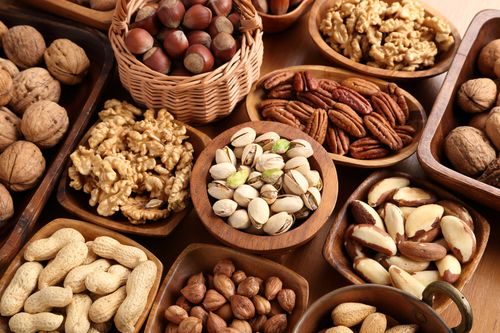03/10/2023
03/10/2023

NEW YORK, Oct 3, (Agencies): Want to elevate the flavors in your recipes and boost their nutrition? Try these simple steps: toss toasted pecans into your salad instead of croutons, add chopped walnuts to your Saturday morning pancake mix, or swirl some peanut butter into the sauce of your vegetable stir-fry. These easy additions bring a delightful nutty twist to your dishes.
Nuts have long been a favorite among nutritionists, thanks to their healthy fat profile. Varieties like walnuts, almonds, pistachios, and hazelnuts are abundant in cholesterol-lowering monounsaturated and polyunsaturated fats while containing lower levels of cholesterol-raising saturated fats. Don't forget peanuts, which, despite being technically legumes, share these heart-healthy attributes.
But there's more to nuts than just their fat content. They are packed with dietary fiber, plant-based protein, vitamin E, and essential minerals like potassium, calcium, and magnesium. This nutritional profile, combined with fats that support heart health, has earned nuts a qualified health claim from the US Food and Drug Administration (FDA). The claim suggests that scientific evidence, while not conclusive, points to the potential of eating 1.5 ounces of nuts daily, as part of a diet low in saturated fat and cholesterol, in reducing the risk of heart disease.
Sharon Palmer, a registered dietitian nutritionist and author of "The Plant-Powered Plan to Beat Diabetes," attests to the benefits of nuts. She emphasizes that incorporating just a handful of nuts into your daily diet can lower LDL (bad) cholesterol levels, promote better blood pressure, and reduce inflammation, all contributing to improved heart health.
Now, you might be wondering how many nuts constitute a "handful" for these heart health benefits. On average, 1.5 ounces or about 1/3 cup is equivalent to a handful, but the exact count per serving varies depending on the nut type. For example, you'll get more tiny pistachios compared to chunky walnut halves.
Curious about other nut varieties? While the FDA's initial qualified health claim omitted some nuts like pecans, macadamias, and cashews due to slightly higher saturated fat levels, further research revealed that macadamia nuts are remarkably high in heart-healthy monounsaturated fats. Consequently, the FDA approved their inclusion in 2017, along with pecans.
However, cashews remain excluded from the FDA's health claim, despite their saturated fat primarily consisting of stearic acid, a type believed to have no effect on blood cholesterol. Studies even suggest that cashews can lower levels of harmful LDL cholesterol.
The evidence supporting nuts as a healthful choice keeps growing. Nuts, with their powerful trio of protein, fiber, and healthy fats, promote a feeling of fullness in meals and snacks, aiding in weight management. They offer potential benefits in preventing diabetes, protecting against cancer, and supporting brain health. Some nuts are even linked to improved gut health, enhanced fertility, and reduced Alzheimer's disease risk.
Notably, certain nuts, like almonds, boast nutrients beneficial for skin health, including vitamin E, selenium, and zinc, which reduce wrinkles and enhance skin tone.
Despite these benefits, it's essential to remember that nuts are calorie-dense due to their high fat content. Hence, a handful is recommended, not an entire can. Consistency is key for reaping the most benefits, as many healthy eating patterns, such as the Mediterranean diet, have included nuts for centuries.
Each nut has a unique nutritional story to tell:
- Almonds are rich in calcium, vitamin E, and dietary fiber, with a substantial protein content of 6 grams per ounce.
- Peanuts, technically legumes, provide ample fiber and a remarkable 7 grams of plant-based protein per ounce, surpassing most tree nuts.
- Pecans stand out for their zinc, iron, and niacin content, ranking second only to almonds in vitamin E content.
- Pistachios excel in potassium and are known for supporting blood pressure control. They match almonds with 6 grams of protein per ounce, while also being a source of vitamin B6 and iron.
- Walnuts are an excellent source of plant-based omega-3 fatty acids, known for reducing inflammation. Additionally, they offer vitamin B6 and magnesium.
If you're unsure which nut to choose, consider mixing things up to enjoy a variety of nutrients from different nuts. Try pecans one day and walnuts the next, or simply opt for a package of mixed nuts.
To save on costs when buying nuts, consider purchasing smaller portions like nut pieces or nut meal. Whole nuts with shells, such as whole almonds or pecan halves, tend to be pricier. Pecan pieces are a more budget-friendly alternative and nut meals, distinct from nut flours, are ground nuts often left from the shelling process, perfect for coatings in dishes like baked chicken, sautéed fish, or roasted vegetables.
Beyond snacking, nuts can enhance various recipes. Add toasted pecan pieces to wild rice or brown rice dishes, use pistachios as a base for basil and garlic pesto, or garnish cooked vegetables with almond slivers. For a satisfying crunch, sprinkle chopped mixed nuts on top of yogurt.
For more culinary inspiration, think beyond the ordinary. Substitute nuts for breadcrumbs to bread chicken or fish, or blend a 50-50 mix of breadcrumbs and finely chopped pecans, pistachios, walnuts, or almonds. When using a box mix to prepare pancakes or muffins, amplify their nutrition by adding finely chopped nuts or nut meals.
By incorporating nuts into your meals and snacks, you not only elevate the flavors of your dishes but also take a significant step toward better health and well-being.
Top of Form


